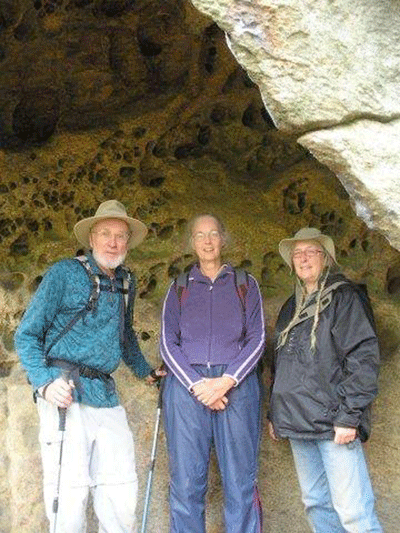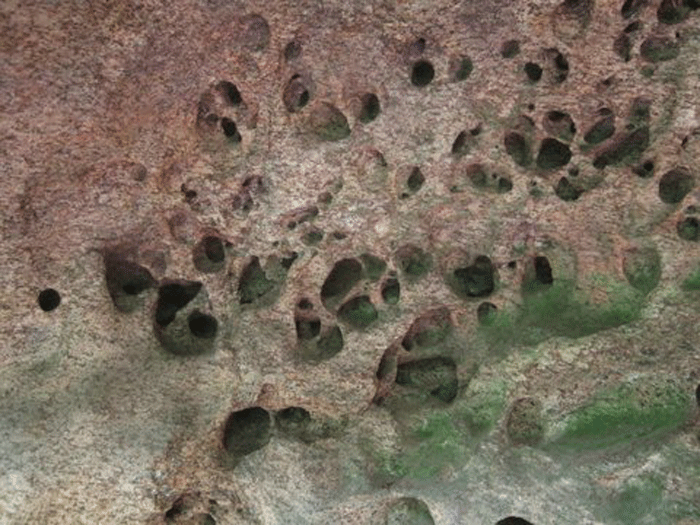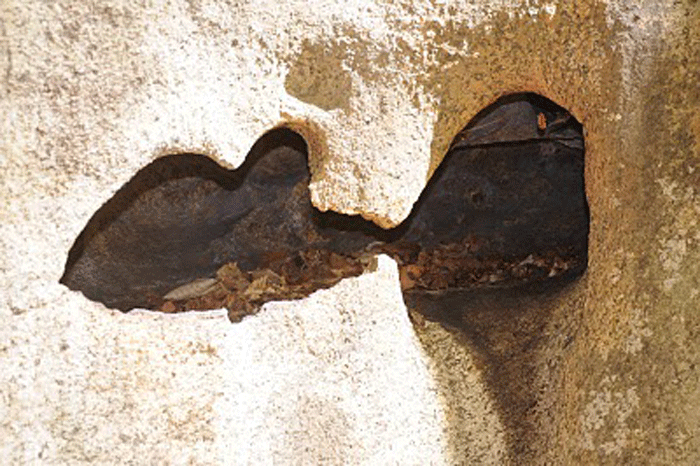At our annual meeting in 1991, one of the forerunners of Protect the Adirondacks, the Residents’ Committee to Protect the Adirondacks (RCPA), led Yngvar Isachsen, the prominent NYS Museum geologist, to a “tafone”–one of the rock formations I used to call “holey boulders” because that is what they are (see pictures below). It was high on a ridge to the west of Garnet Lake, on private land. Yngvar had no idea how this strange rock could have been created or why it was there. He had never seen anything like it in all his field trips and studies throughout the state. Right then I gave up trying to understand the four foot long, four foot high hollow rock with a three inch round hole opening to the outside at one end. Like all of our tafoni (which word I use for the cavities) it was totally lined except the floor with often very complex, rounded depressions which I now know are called “nested honeycomb”. (Accent is on the first syllable as it is probably from a Corsican word for “perforate”.) Definitions elsewhere call these small depressions “tafoni”; maybe our formations are unique being cavities in a boulder lined with honeycomb.
About 25 years later I found out about an area that had a dozen and a half of these puzzling cavities in boulders (some as big as a small house) below a 60 foot high cliff that had three honeycomb lined cavities still embedded in the cliff face. A hunter friend also led me to the one that is near Thirteenth Lake. Both of these areas are state land. We New Yorkers own these almost totally unknown mysterious puzzles! The most spectacular tafone is near Elizabethtown, unfortunately on private land. They are all made of granitic gneiss, which is the bedrock of about half of the Adirondacks. So why are tafoni so rare?
 One of the puzzling aspects of our tafoni is that fretting and honeycomb type erosion is found all over the world but on ocean shores or in deserts, neither of which fit the Adirondacks. And usually the honeycomb is on the outside surface of rock. When cavities are formed elsewhere they are usually smooth inside, not covered with nested honeycomb. What happened here, and when, under what conditions? The tafoni near Thirteenth Lake and Garnet Lake presumably were transported by glacier but must have formed after they were in place as their fragile forms would have been destroyed by the glacier.
One of the puzzling aspects of our tafoni is that fretting and honeycomb type erosion is found all over the world but on ocean shores or in deserts, neither of which fit the Adirondacks. And usually the honeycomb is on the outside surface of rock. When cavities are formed elsewhere they are usually smooth inside, not covered with nested honeycomb. What happened here, and when, under what conditions? The tafoni near Thirteenth Lake and Garnet Lake presumably were transported by glacier but must have formed after they were in place as their fragile forms would have been destroyed by the glacier.
Geologists in other parts of the world know a lot about how honeycomb and fretting are formed, with salt crystallization being a very common part of the process. Granitic gneiss, a granular rock, has some grains which are salts (but not NaCl) which when wetted absorb water and can grow and pry apart the other mineral grains. Alternating heating and cooling, wetting and drying are necessary too. Ocean spray can coat the rock and drying by evaporation allows crystals to grow. Our asbestos Adirondacks do not now seem to fill the bill for the conditions necessary for creating tafoni.
That running water from glaciers or any other source has nothing to do with tafoni is agreed by all geologists who study tafone. Some rock such as limestone, sandstone, and granite, hard though it seems to us, can be porous and allow water to seep through it. “Case hardening”, where certain chemicals seep through to the outside of a boulder, can make the outside more resistant to erosion, and hanging “visors” often remain when the inside of a boulder is hollowed out and covered with nested honeycomb. Here there do not seem to be intermediate tafoni that are still forming. But sand eroded from the rock is visible in many of the “alveoles” and on the floors.
The tafone are an interesting geological wonder in the Adirondacks.


